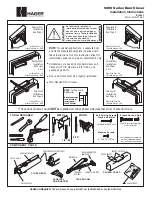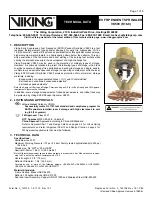
Page 19 of 20
507389-02
Issue 1733
Heat Exchanger Removal and Cleaning
1. Remove the heat exchanger access panel
2. Remove the combustion inducer as described
previously.
3. Disconnect the two orange leads from the primary limit
switch at the vest panel.
4. Disconnect the upper and lower drain hoses from the
condensate drain.
5.
Remove the four screws at the rear vest panel flange.
6. Remove the three screws at the bottom vest panel
flange.
7. Remove the three screws on the top panel of the unit
that secure the vest panel.
8. Disconnect the supply air duct if it cannot be lifted
slightly to allow the top panel to be tilted upward.
9. Remove the two screws closest to the front of the unit
on each side of the top panel so it can be tilted upward.
10. Tilt the front edge of the top panel upward and remove
the heat exchanger assembly from the cabinet. Take
care to avoid damaging insulation or other components.
11. With the heat exchanger assembly out of the cabinet,
remove the twelve screws securing the hot end header
box to the coil rear end sheet.
12. Remove the turbulators from the secondary coil tubes.
13.
Back wash the heat exchanger with soapy water
solution or steam. If steam is used its temperature
must be below 275°F (135°C).
14. Thoroughly rinse and drain the heat exchanger. Soap
solutions can be corrosive. Take care to rinse the
entire assembly.
15. For reassembly, follow the above steps in reverse
order.
Cooling Chassis
The refrigeration system contained in the cooling chassis
normally requires no maintenance since it is a closed,
self-contained system. System is charged with R410A
refrigerant. Periodic maintenance is limited to:
•
Cleaning the air filter. Follow directions noted on the
filter and label attached to the access panel.
• Cleaning the condenser coil if covered with any foreign
material, lint, leaves, or other obstructions.
If servicing or major repairs are required, the complete
chassis can be removed from the unit. To remove the
chassis:
1. Shut off the main power supply.
2.
Remove filter access panel and panel covering cooling
controls.
3. Remove drain hose from the drain pan.
4. Disconnect the plug-in electrical connections. Do not
separate the connector by pulling on this wire; instead,
grasp the connector handle.
5. Disconnect two power leads at contactor (leads come
from grommet in unit partition).
6. Remove screws from panel directly in front of blower
and remove panel. Also remove additional screws
located near top edge of control panel.
7. Drape power wires and wire harnesses out of cabinet
and tape to upper panel.
8. Slide out the chassis, being careful not to damage any
seals or parts. Particular care should be taken to insure
wiring is not damaged during removal/reinstallation
process.
To reinstall the chassis, reverse the procedure outlined
above. Be sure that the chassis is inserted as far back as
it will go before replacing the screws. Side flanges on the
chassis must be engaged with sealing strips on the unit
sides to prevent water and air leakage. Reconnect the
wire harness, reconnect the power leads, and replace both
access panels before turning on the main electrical power.
Tubing is not to be used as a handle.


































